Evolution Characteristics of Strain and Displacement Fields in Double-Hole Short-Delay Blasting Based on DIC
Abstract
:1. Introduction
2. DIC Technology System
3. The Basic Principles of DIC
4. Pilot Program
5. Test Results and Analysis
5.1. Static Calibration of Speckle Quality
5.2. Evolution of the Principal Strain with Various Delay Times
5.3. Maximum Principal Strain Law
5.4. Trends in Displacement under Different Delay Times
6. Conclusions
- (1)
- The propagation speed of explosion stress waves in the PMMA board is extremely fast, with an explosion process occurring on the order of microseconds. Combined with a high-speed camera with a frame rate of 20,000 fps, the DIC system enables full-surface visualization of the explosive deformation of a 400 × 300 mm PMMA board.
- (2)
- There is an optimal delay time between 0 µs and 40 µs, which makes the compressive and tensile principal strain peaks between the two holes larger, and the time interval between the two principal strain peaks shorter (more frequent deformation), thus making the penetration fracture between the two holes more likely.
- (3)
- The maximum principal strain at different points on the vertical line between two blasting holes decreases exponentially with the increase in distance from the blasting center. In the delay time between 0 µs and 40 µs, there is a delay time that can not only ensure a good penetrating fracture between two blasting holes, but also reduce the impact on other areas.
- (4)
- In the delay time of 0~40 µs, with the extension of the delay time, the displacement trend between the two holes changes from shear to tensile, and the vulnerable damage area gradually becomes larger, thus making the damage between the two holes more likely to occur.
- (5)
- In the blasting process, choosing a reasonable delay time can not only improve the crushing effect of rock, but also reduce the damage to other areas to a certain extent.
Author Contributions
Funding
Data Availability Statement
Conflicts of Interest
References
- Yang, H.G.; Kim, S.J.; Min, A.J. Advancement of blast effect by inducing drill jumbo on automatic drilling system. Explos. Blasting 2016, 34, 10–17. [Google Scholar]
- Zhang, Z.; Hosseini, S.; Monjezi, M.; Yari, M. Extension of reliability information of Z-numbers and fuzzy cognitive map: Development of causality-weighted rock engineering system to predict and risk assessment of blast-induced rock size distribution. Int. J. Rock Mech. Min. Sci. 2024, 178, 105779. [Google Scholar] [CrossRef]
- Sun, Q.; Wang, Q.; Yang, L. Explosion loading model experiment system based on DlC and its application. Res. Explor. Lab. 2018, 37, 87–91. [Google Scholar]
- Ylitalo, R.M.; Zhang, Z.-X.; Pekka, B. Effect of detonator position on rock fragmentation: Full-scale field tests at Kevitsa open pit mine. Int. J. Rock Mech. Min. Sci. 2021, 147, 104918. [Google Scholar] [CrossRef]
- Zhang, Z.-X.; Ouchterlony, F. Energy requirement for rock breakage in laboratory experiments and engineering operations: A review. Rock Mech. Rock Eng. 2022, 55, 629–667. [Google Scholar] [CrossRef]
- Johansson, D.; Ouchterlony, F. Shock wave interactions in rock blasting: The use of short delays to improve fragmentation in model-scale. Rock Mech. Rock Eng. 2013, 46, 1–18. [Google Scholar] [CrossRef]
- Hashemi, S.A.; Katsabanis, P. The effect of stress wave interaction and delay timing on blast-induced rock damage and fragmentation. Rock Mech. Rock Eng. 2020, 53, 2327–2346. [Google Scholar] [CrossRef]
- Ding, W.; Liu, D. Blasting-induced peak particle velocity prediction of hole-by-hole blasting operation using digital electronic detonator in open-pit mine. Earth Sci. 2023, 48, 2000–2010. [Google Scholar]
- Han, B.; Ma, Q. Research on testing and controlling techniques of millisecond delay blasting vibration in coal mine rock roadway. J. China Coal Soc. 2013, 38, 209–214. [Google Scholar]
- Zhang, X.; Yan, P.; He, H.; Zhang, X.; Lu, W.; Liu, B.; Zhu, J.; Wang, X.; Cheng, Y. Experimental investigations of the effect of millisecond-delay time on the blast vibration reduction with electronic detonators. J. Vib. Control 2023, 29, 17–18. [Google Scholar] [CrossRef]
- Choi, S.-O. A Study on Delay Time Control for Lowering Grounding Vibration and Noise Induced by Blasting. Explos. Blasting 2014, 32, 18–25. [Google Scholar]
- Li, Q.; Yu, Q.; Zhang, D.; Cheng, Y.; Peng, Y.; Feng, D. Metro tunnel precisely controlled blasting’s delay time optimization and its application. J. Vib. Shock 2018, 37, 135–140+170. [Google Scholar]
- Xu, H.; Lu, W.; Chen, M.; Li, R. Study on superposition effect of blasting vibration induced by delay error of detonators using genetic algorithm. Rock Soil Mech. 2008, 29, 1900–1904. [Google Scholar]
- Sharma, M.; Choudhary, B.S.; Kumar, H.; Agrawal, H. Optimization of delay sequencing in multi-row blast using single hole blast concepts. J. Inst. Eng. (India) Ser. D 2021, 102, 453–460. [Google Scholar] [CrossRef]
- Rossmanith, H.P.; Kouzniak, N. Supersonic detonation in rock mass-part 2: Particle displacements and velocity fields for single and multiple non-delayed and delayed detonating blastholes. Fragblast 2004, 8, 95–117. [Google Scholar] [CrossRef]
- Rossmanith, H.P. The use of Lagrange diagrams in precise initiation blasting. Part I: Two interacting blastholes. Fragblast 2002, 6, 104–136. [Google Scholar] [CrossRef]
- Liang, X.; Ding, C.; Zhu, X.; Zhou, J.; Chen, C.; Guo, X. Visualization study on stress evolution and crack propagation of jointed rock mass under blasting load. Eng. Fract. Mech. 2024, 296, 109833. [Google Scholar] [CrossRef]
- Tang, H.-L.; Liu, X.; Yang, J.; Yu, Q. V Experimental study on the influence of delay time on rock fragmentation in bench blasting. Appl. Sci. 2023, 13, 85. [Google Scholar] [CrossRef]
- Li, C.; Yang, R.; Wang, Y.; Kang, Y.; Zhang, Y.; Xie, B. Theoretical and numerical simulation investigation of deep hole dispersed charge cut blasting. Int. J. Coal Sci. Technol. 2023, 10, 15. [Google Scholar] [CrossRef]
- Yamaguchi, I. A laser-speckle strain gauge. J. Phys. E Sci. Instrum. 1981, 14, 1270–1273. [Google Scholar] [CrossRef]
- Yuan, Y.; Pan, P.; Zhao, S.; Wang, B.; Song, G. The failure process of marble with filled crack under uniaxial compression based on digital image correlation. Chin. J. Rock Mech. Eng. 2018, 37, 339–351. [Google Scholar]
- Zhao, S.; Tian, J.; Matsuda, H.; Zhao, C.; Bao, C. Crack propagation and damage of rock under uniaxial compression based on global strain field analysis. Chin. J. Rock Mech. Eng. 2015, 34, 763–769. [Google Scholar]
- Zhu, X.; Fan, J.; He, C.; Tang, Y. Identification of crack initiation and damage thresholds in sandstone using 3D digital image correlation. Theor. Appl. Fract. Mech. Eng. 2022, 122, 103653. [Google Scholar] [CrossRef]
- Qiao, Y.; Guan, X.-B.; Zhang, Z.-X. Experimental study on crack propagation pattern and fracture process zone evolution based on far-field displacement by using DIC. Sci. Rep. 2023, 13, 19523. [Google Scholar] [CrossRef] [PubMed]
- Liu, X.; Yang, J.; Xu, Z.; Guo, L.; Tang, H. Experimental investigations on crack propagation characteristics of granite rectangle plate with a crack (GRPC) under different blast loading rates. Shock Vib. 2020, 2020, 1–18. [Google Scholar] [CrossRef]
- Xing, H.; Zhao, J.; Wu, G.; Ruan, D.; Dehkhoda, S.; Lu, G.; Zhang, Q. Perforation model of thin rock slab subjected to rigid projectile impact at an intermediate velocity. J. Impact Eng. 2020, 139, 103536. [Google Scholar] [CrossRef]
- Ding, C.; Yang, R.; Feng, C.; Tang, Y. Stress wave superposition effect and crack initiation mechanism between two adjacent boreholes. Int. J. Rock Mech. Min. Sci. 2021, 138, 104622. [Google Scholar] [CrossRef]
- Kakogiannis, D.; Verleysen, P.; Belkassem, B.; Coghe, F.; Rabet, L. Multiscale modelling of the response of Ti-6AI-4V sheets under explosive loading. J. Impact Eng. 2018, 119, 1–13. [Google Scholar] [CrossRef]
- Chen, P.; Zhou, Z.; Ma, S.; Ma, Q.; Huang, F. Measurement of dynamic fracture toughness and failure behavior for explosive mock materials. Front. Mech. Eng. 2011, 6, 292–295. [Google Scholar] [CrossRef]
- Xu, Z.; Yang, J.; Guo, L. Study of the splitting crack propagation morphology using high-speed 3D DIC. Explos. Shock Waves 2016, 36, 400–406. [Google Scholar]
- Aune, V.; Fagerholt, E.; Hauge, K.O.; Langseth, M.; Borvik, T. Experimental study on the response of thin aluminium and steel plates subjected to airblast loading. J. Impact Eng. 2016, 90, 106–121. [Google Scholar] [CrossRef]
- Arora, H.; Del Linz, P.; Dear, J.P. Damage and deformation in composite sandwich panels exposed to multiple and single explosive blasts. Int. J. Impact Eng. 2017, 104, 95–106. [Google Scholar] [CrossRef]
- Takahashi, Y.; Kubota, S.; Saburi, T. Influence of partially dense regions near free surface on stress wave interference and crack propagation in laboratory blasting tests. Sci. Technol. Energ. Mater. 2022, 84, 103–110. [Google Scholar]
- Sun, Q.; Wang, Q.; Liu, G.; Li, X. Proximity side blasting based on ultra-high speed DIC method strain field analysis of subway tunnels. J. Min. Sci. Technol. 2018, 3, 39–45. [Google Scholar]
- Cheng, B.; Li, D. Full-field dynamic measurement method for fatigue cracks based on decorrelation DIC. Chin. J. Theor. Appl. Eng. 2022, 54, 1040–1050. [Google Scholar]
- Lu, H.; Cary, P.D. Deformation measurements by digital image correlation: Implementation of a second-order displacement gradient. Exp. Mech. 2000, 40, 393–400. [Google Scholar] [CrossRef]
- Yue, Z.; Zhang, S.; Qiu, P.; Song, Y.; Lu, Y.; Sun, Y. Mechanism of explosive crack propagation with slotted cartridge millisecond blasting. J. China Coal Soc. 2018, 43, 638–645. [Google Scholar]
- Yang, R.; Ding, C.; Yang, L.; Lei, Z.; Zheng, C. Study of decoupled charge blasting based on high-speed digital image correlation method. Tunn. Undergr. Space Technol. 2019, 83, 51–59. [Google Scholar] [CrossRef]
- Park, J.; Yoon, S.; Kwon, T.-H.; Park, K. Assessment of speckle-pattern quality in digital image correlation based on gray intensity and speckle morphology. Opt. Lasers Eng. 2017, 91, 62–72. [Google Scholar] [CrossRef]
- Wu, X.; Gong, M.; Wu, H.; Hu, G.; Wang, S. Vibration reduction technology and the mechanisms of surrounding rock damage from blasting in neighborhood tunnels with small clearance. Int. J. Min. Sci. Technol. 2003, 33, 625–637. [Google Scholar] [CrossRef]


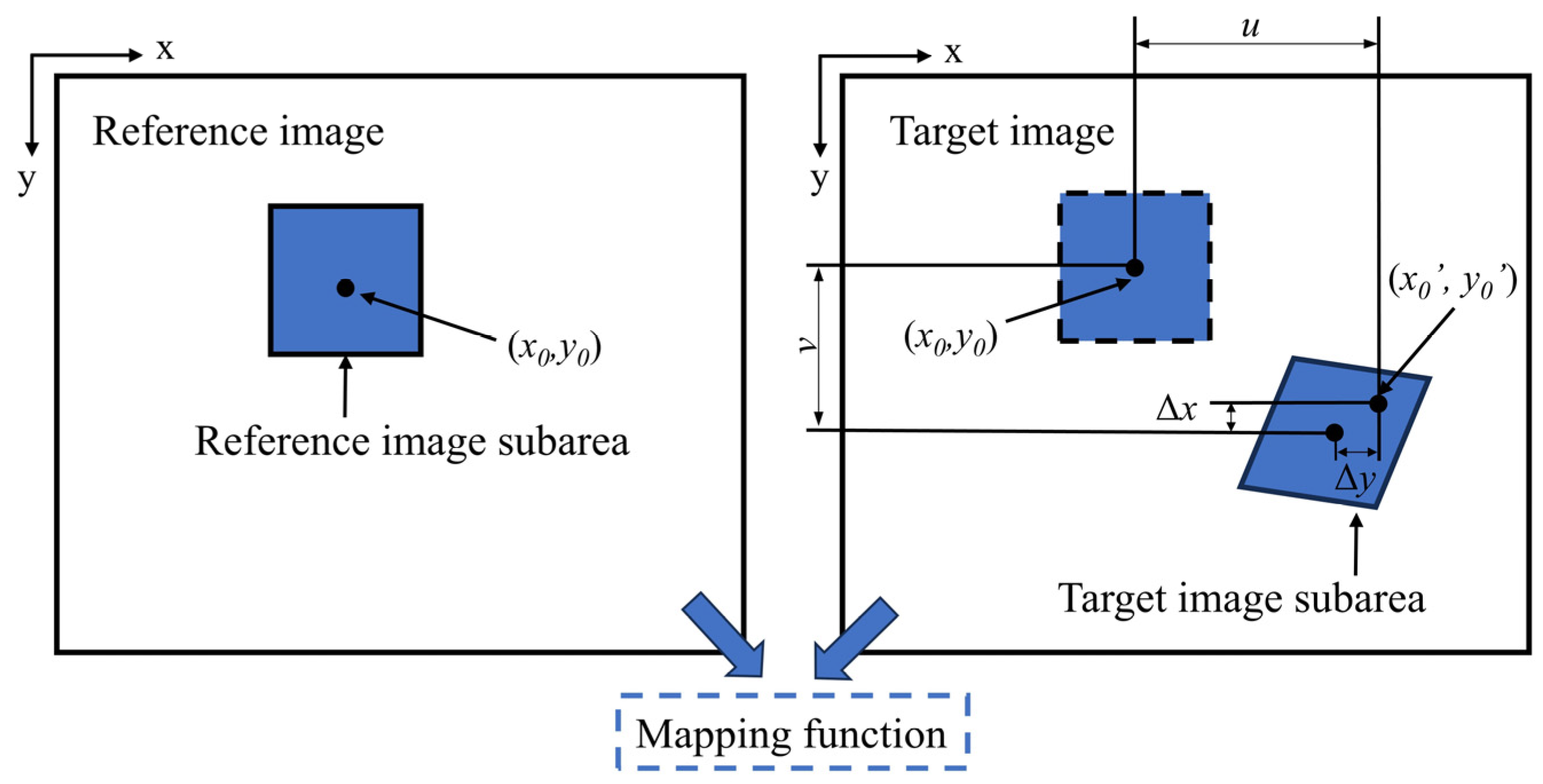
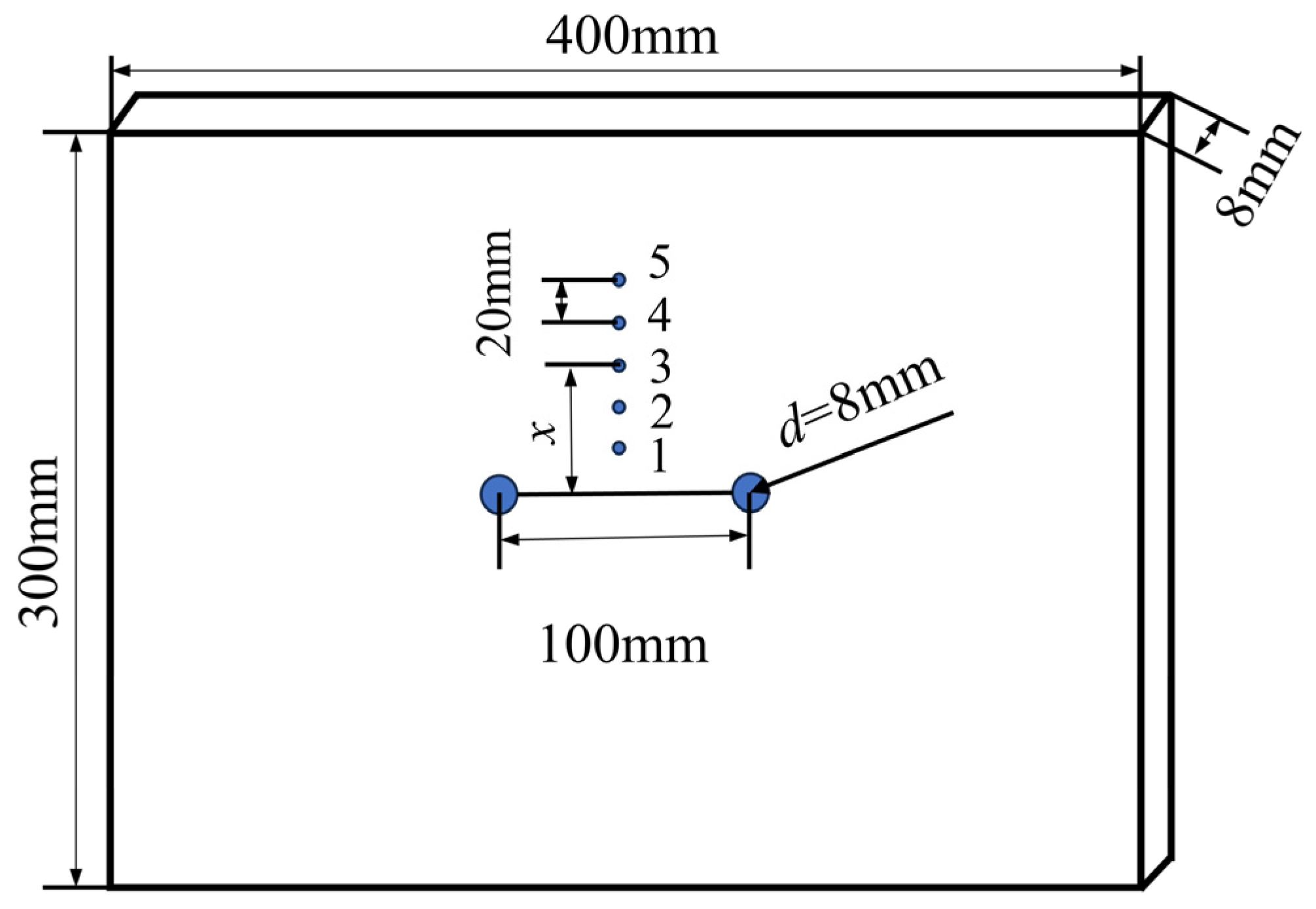
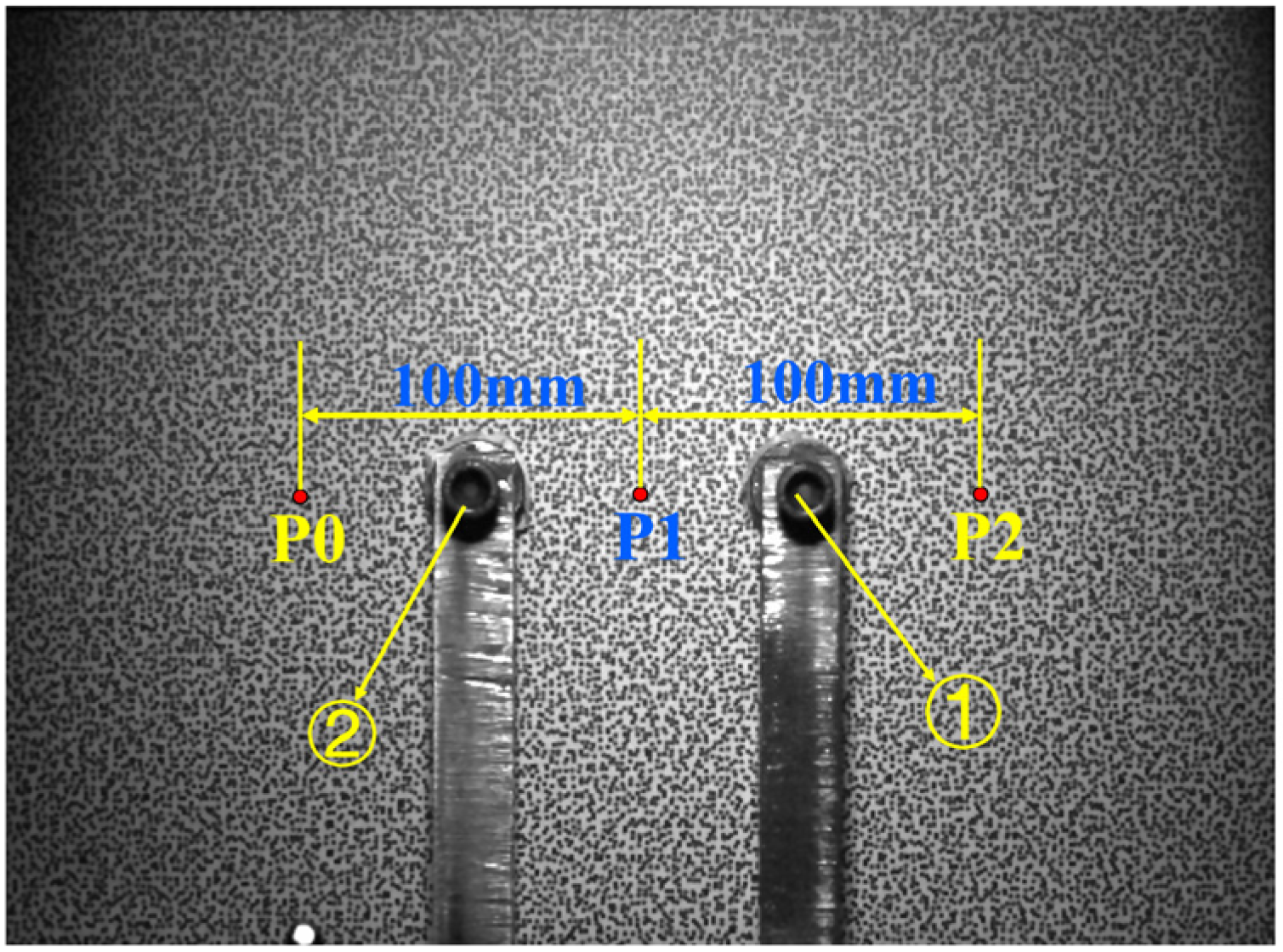
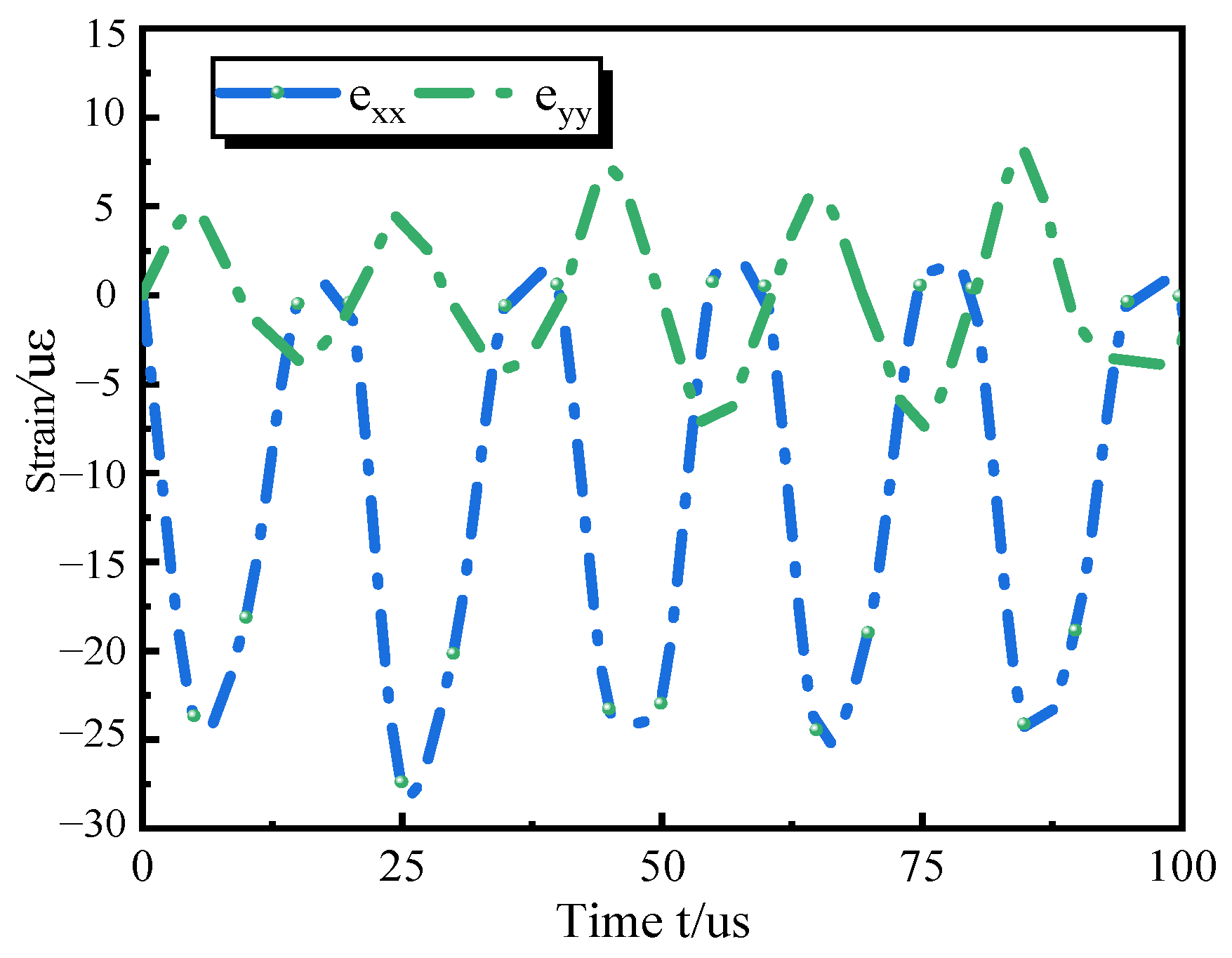
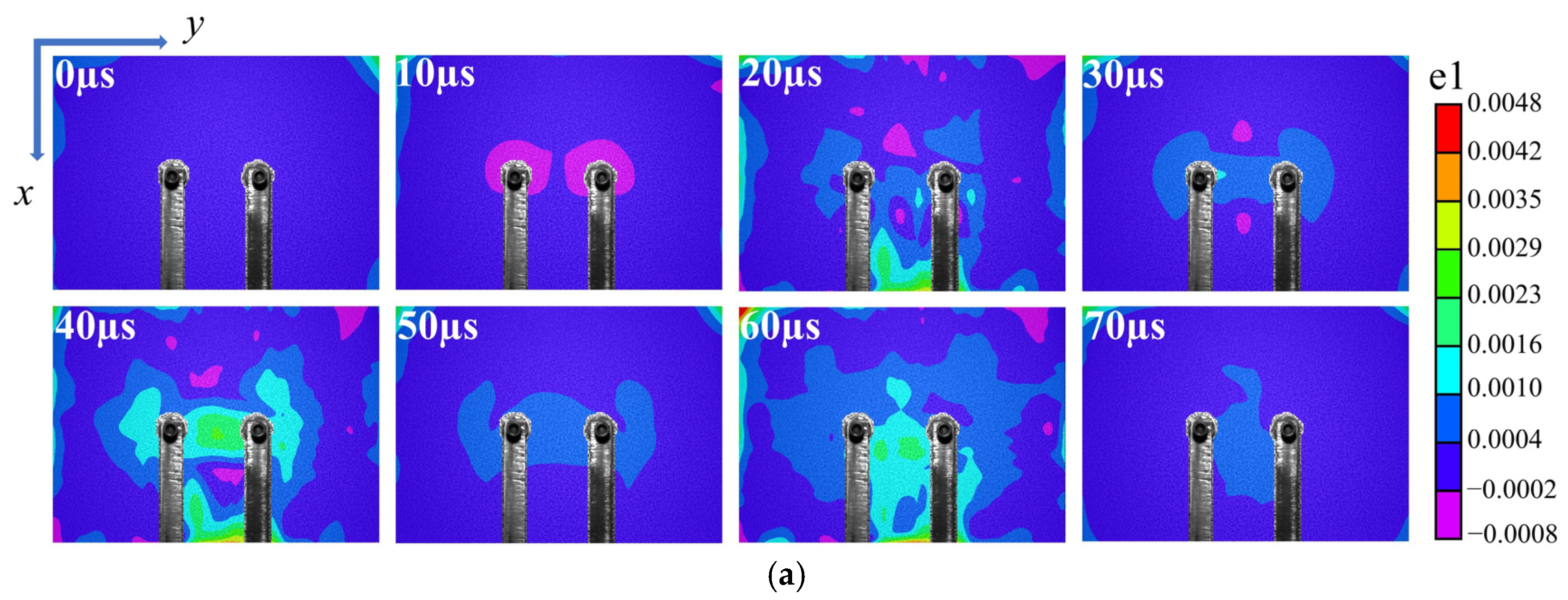

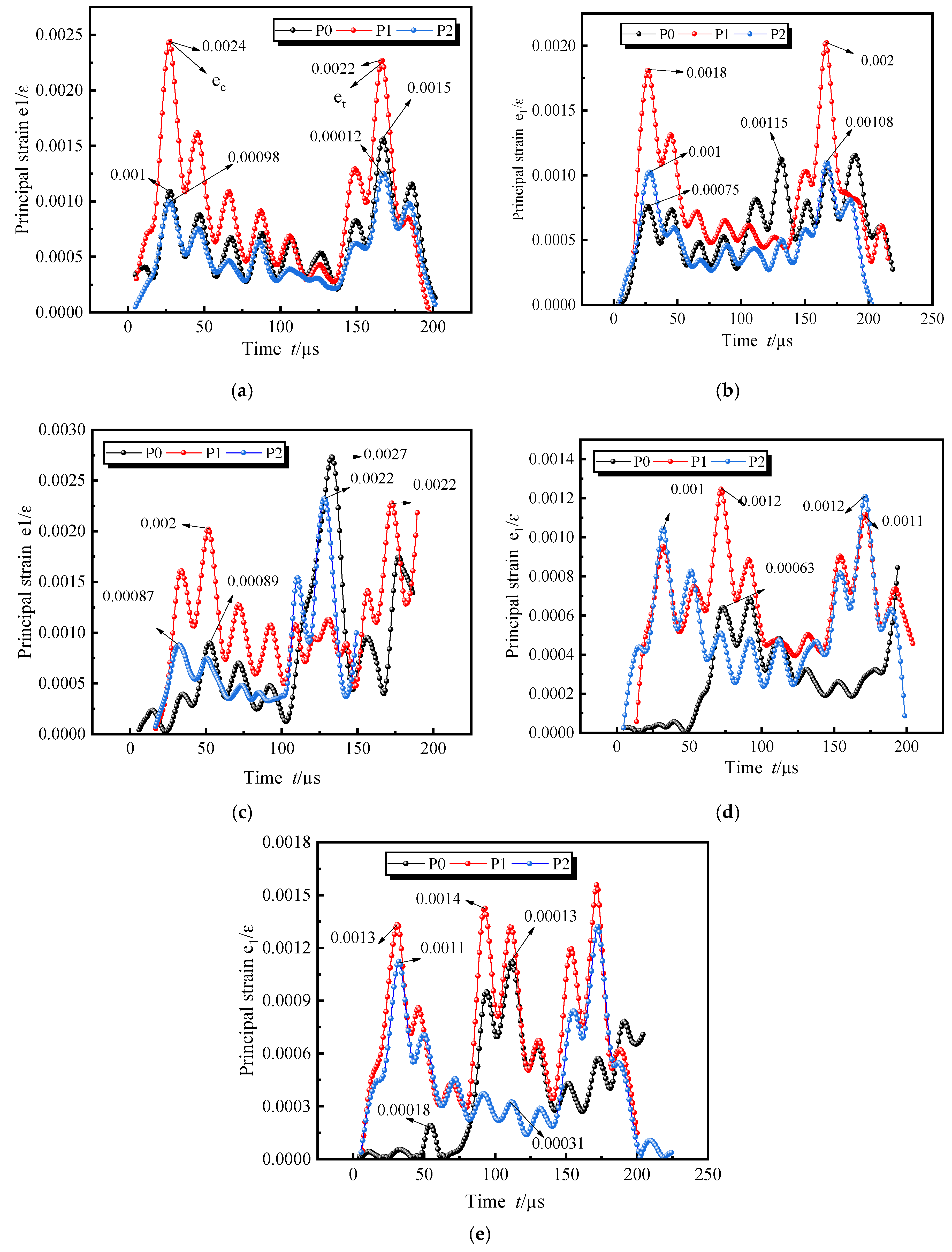
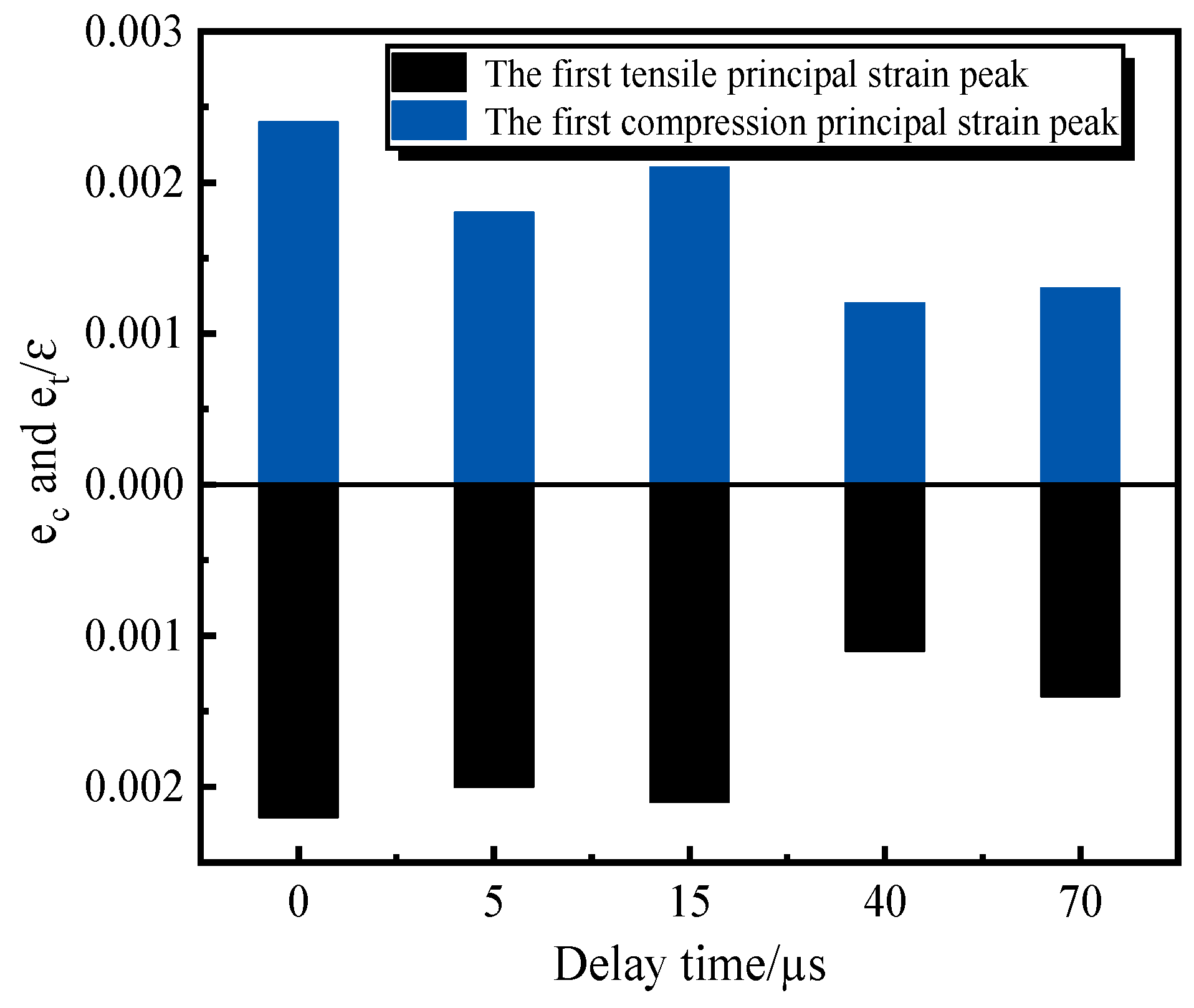
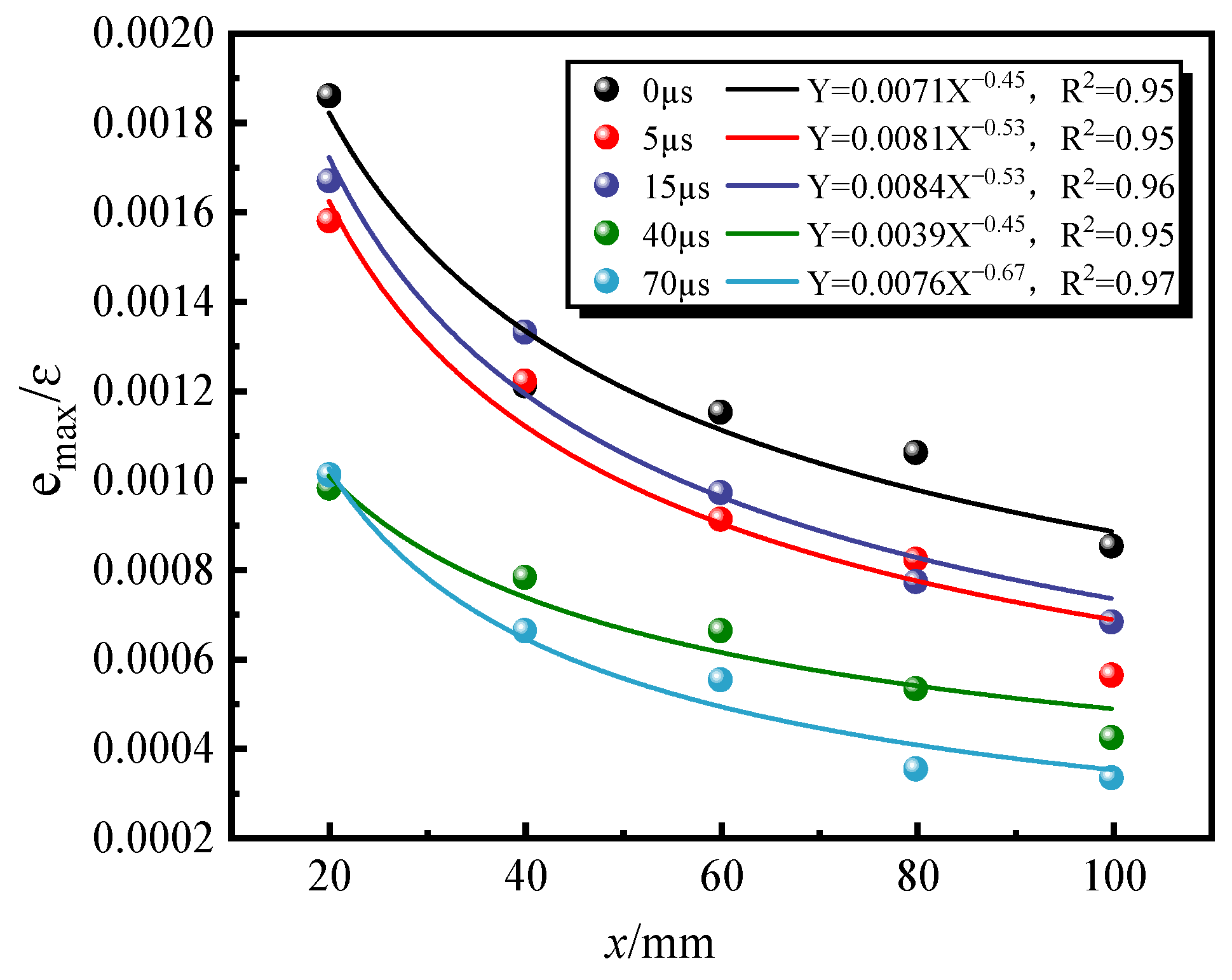
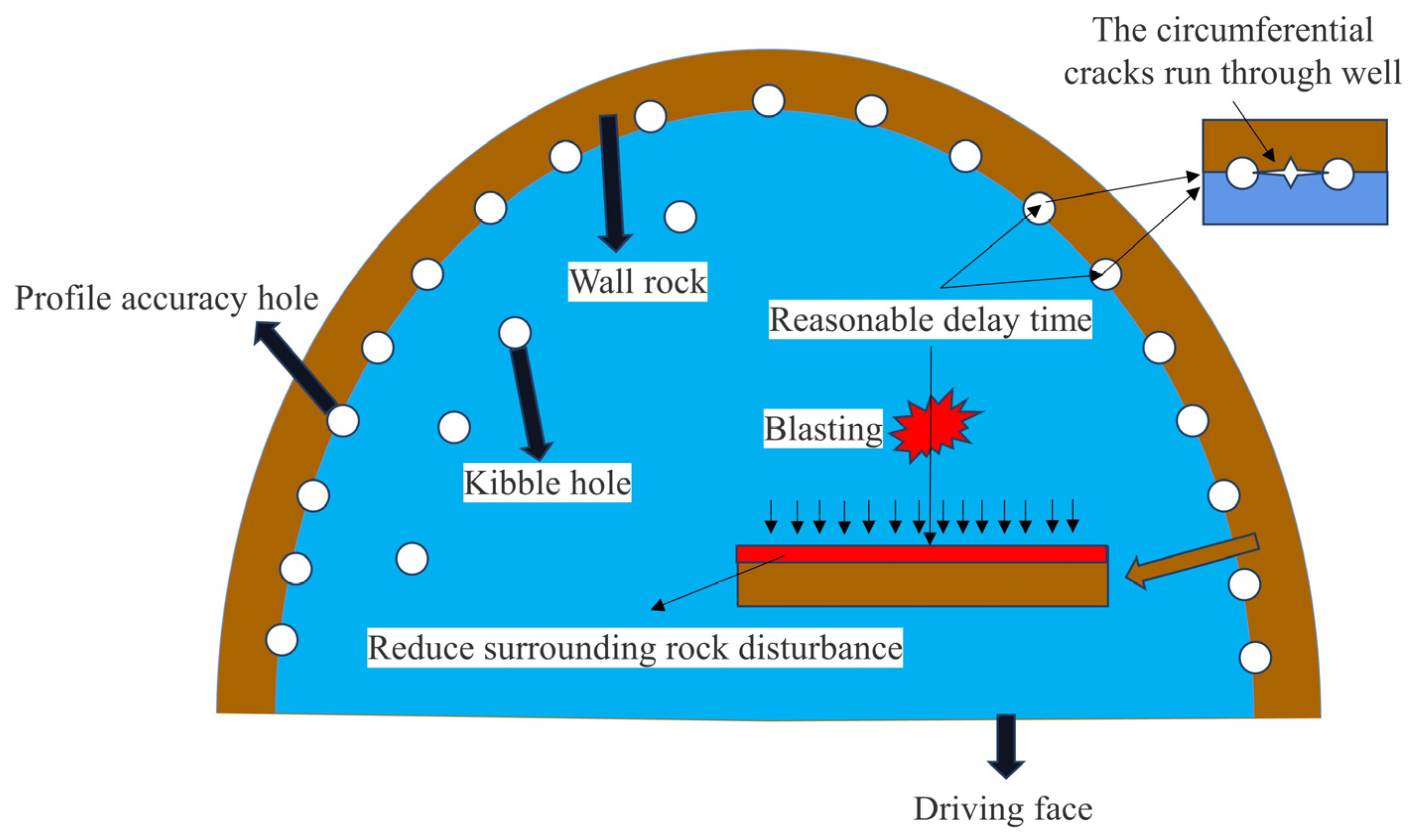
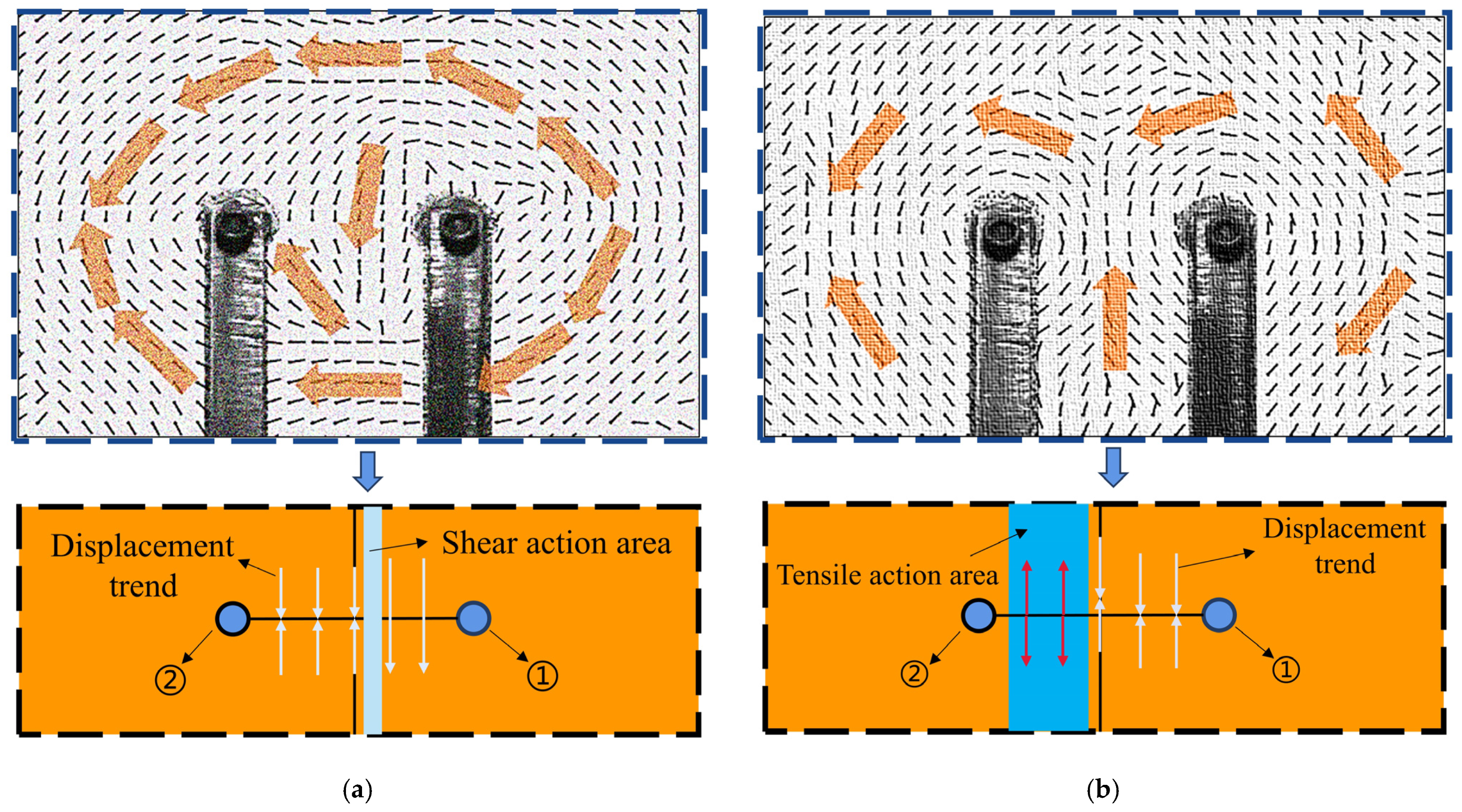


| Longitudinal Wave Velocity/(m·s−1) | Shear Wave Speed/(m·s−1) | Elastic Modulus/GPa | Poisson Ratio | Optical Constant/(m2·N−1) |
|---|---|---|---|---|
| 2320 | 1260 | 6.1 | 0.28 | 0.85 × 10−10 |
| Charge Density/g·cm−3 | Critical capacity/L·kg−1 | Explosion heat/°C | Explosive Velocity/m·s−1 | Explosive Pressure/GPa |
|---|---|---|---|---|
| 2.51 | 308 | 3050 | 4478 | 9.31 |
Disclaimer/Publisher’s Note: The statements, opinions and data contained in all publications are solely those of the individual author(s) and contributor(s) and not of MDPI and/or the editor(s). MDPI and/or the editor(s) disclaim responsibility for any injury to people or property resulting from any ideas, methods, instructions or products referred to in the content. |
© 2024 by the authors. Licensee MDPI, Basel, Switzerland. This article is an open access article distributed under the terms and conditions of the Creative Commons Attribution (CC BY) license (https://creativecommons.org/licenses/by/4.0/).
Share and Cite
Zhou, Z.; Ma, J.; Wang, J.; Guan, S.; Zhang, X.; Yang, Y. Evolution Characteristics of Strain and Displacement Fields in Double-Hole Short-Delay Blasting Based on DIC. Processes 2024, 12, 1291. https://doi.org/10.3390/pr12071291
Zhou Z, Ma J, Wang J, Guan S, Zhang X, Yang Y. Evolution Characteristics of Strain and Displacement Fields in Double-Hole Short-Delay Blasting Based on DIC. Processes. 2024; 12(7):1291. https://doi.org/10.3390/pr12071291
Chicago/Turabian StyleZhou, Zeqing, Jun Ma, Jianguo Wang, Si Guan, Xiaohua Zhang, and Yang Yang. 2024. "Evolution Characteristics of Strain and Displacement Fields in Double-Hole Short-Delay Blasting Based on DIC" Processes 12, no. 7: 1291. https://doi.org/10.3390/pr12071291





